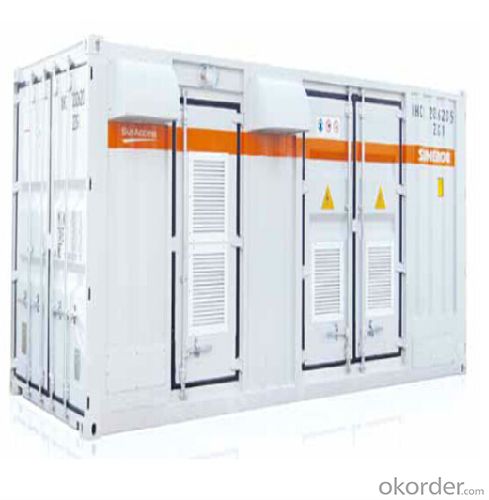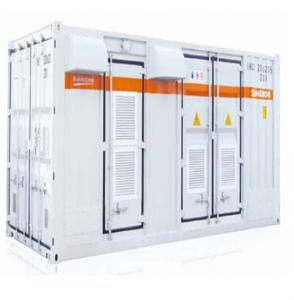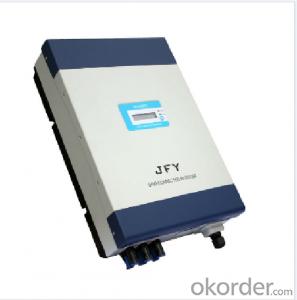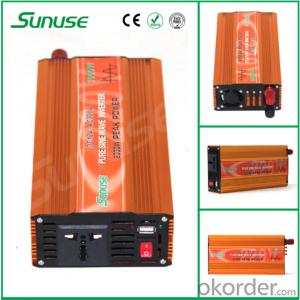Photovoltaic Grid-Connected Inverter SG1000TS-MV
- Loading Port:
- China Main Port
- Payment Terms:
- TT or LC
- Min Order Qty:
- 50 unit
- Supply Capability:
- 1000 unit/month
OKorder Service Pledge
OKorder Financial Service
You Might Also Like
1. Structure of Photovoltaic Grid-Connected Inverter SG1000TS-MV Description
A solar inverter, or PV inverter, or Solar converter, converts the variable direct current (DC) output of a photovoltaic (PV) solar panel into
autility frequency alternating current (AC) that can be fed into a commercial electrical grid or used by a local, off-grid electrical network.
It is acritical BOS–component in a photovoltaic system, allowing the use of ordinary AC-powered equipment. Solar inverters have
special functions adapted for use with photovoltaic arrays, including maximum power point tracking and anti-islanding protection.
Suitable for 50Hz/60Hz grid, could be used in Asia, North America and Europe.
2. Main Features of the Photovoltaic Grid-Connected Inverter SG1000TS-MV
• Turn-key solution,high integration
• Integrated PV inverter, DC/AC power distribution, medium-voltage transformer, system monitoring, fire alarm, environment monitoring functional modules and so on
• Save AC cables, lower consumption and promote users’ benefits
• SCADA monitoring system integrated to reduce the costs and ensure the optimal status of the plant
* Easy for Transportation and Handling, Environment Adaptable
• Container design, easy for transportation
• Integral hoisting, easy to install, reduce the installation cost and risks.
• Standard container enclose, integrated design for ventilation, sandproof, anti-corrosion and anti-low-temperature and other application requirements.
* Advanced Technology, Grid-friendly
• Efficiency, energy-saving and reliability as with all Sungrow inverters
• Integrated with standard power dispatch interfaces, convenient and flexible access to power grid;
• LVRT (Zero-voltage Ride-through), Reactive power control with power factor from 0.9 lagging to 0.9 leading, Give reactive power compensation to the grid at night according to directive
3. Photovoltaic Grid-Connected Inverter SG1000TS-MV Images


4. Photovoltaic Grid-Connected Inverter SG1000TS-MV Specification
Side Data | |
Max. DC power (@ cos φ =1) | 1120kW |
Max. input voltage | 1000V |
Start voltage | 500V |
Min. working voltage | 460V |
Max. input current | 2440A |
MPPT voltage range | 460~850V |
Number of DC inputs | 16/32 |
Output Side Data | |
Rated power | 1000kW |
Max. output AC power | 1100kVA |
Max. output current | 63.5A |
Max. THD | <3%(at nominal power) |
Rated grid voltage | 10-24kV |
Rated grid frequency | 50Hz / 60Hz |
Grid frequency range | 47~52Hz / 57 ~62Hz |
Power factor at rated power | >0.99 |
DC current injection | <0.5% of rated inverter output current |
Adjustable displacement factor | 0.9 (lagging) ~0.9 (leading) |
Efficiency | |
Max. efficiency | 98.00% |
European efficiency | 97.50% |
Protection | |
DC input side disconnection device | Switch-disconnector with fuses |
AC output side disconnection device | Switch-disconnector with fuses |
DC overvoltage protection | Yes |
AC overvoltage protection on the LV side | Yes |
Grid monitoring | Yes |
Ground fault monitoring | Yes |
Overheat protection | Yes |
Insulation monitoring | Yes |
General Data | |
Dimensions(W×H×D) | 6058x2591x2438mm |
Weight | 12T |
Operating temperature range | -35~50℃ |
External auxiliary supply voltage (Opt.) | 380V |
Cooling concept | Temperature controlled air-cooling |
Degree of protection | IP54 |
Max. permissible value for relative humidity (non-condensing) | 0~95%, non -condensing |
Max. altitude | 6000m (derating > 3000m) |
Communication port/protocols | Standard: RS485/ Modbus, Internet |
Options: CDT, DNP3.0, 101, 103, 104, GPRS/CDMA module | |
5. FAQ of Photovoltaic Grid-Connected Inverter SG1000TS-MV
Q1. What is the difference between inverter and solar inverter?
A1. Inverter only has AC inpput, but solar inverter both connect to AC input and solar panel, it saves more power.
Q2. What is the difference between MPPT&PWM?
A2. MPPT has higher efficiency, it can track the max power point and won't waste energy.
- Q:Can a solar inverter be connected to a battery storage system?
- Yes, a solar inverter can be connected to a battery storage system. This allows the excess energy generated by the solar panels to be stored in the battery for later use, providing backup power during times when the solar panels are not producing enough electricity.
- Q:What is the role of a power quality analyzer in a solar inverter?
- The role of a power quality analyzer in a solar inverter is to monitor and analyze the quality of the electrical power being generated by the solar panels. It measures various parameters such as voltage, current, frequency, harmonics, and power factor to ensure that the power being generated is within acceptable limits and meets the required standards. By detecting any deviations or abnormalities in the power quality, the analyzer helps in identifying and rectifying issues that could affect the performance and efficiency of the solar inverter and the overall solar power system.
- Q:Can a solar inverter be used in a commercial or industrial setting?
- Yes, a solar inverter can be used in a commercial or industrial setting. In fact, they are commonly used in these settings to convert the direct current (DC) electricity generated by solar panels into alternating current (AC) electricity that can be used to power various commercial and industrial equipment. Solar inverters are essential components of solar power systems in such settings and play a crucial role in maximizing energy efficiency and reducing reliance on conventional power sources.
- Q:What is the role of a solar inverter in preventing electrical faults?
- The role of a solar inverter in preventing electrical faults is to convert the direct current (DC) electricity generated by solar panels into alternating current (AC) electricity that can be used in homes and businesses. In doing so, the inverter helps maintain a stable and consistent flow of electricity, which reduces the risk of electrical faults such as short circuits, overloads, or voltage fluctuations. It also includes various protection mechanisms, such as ground fault detection and interruption, to ensure the safety and reliability of the solar power system.
- Q:Can a solar inverter be used with solar-powered water purification systems?
- Yes, a solar inverter can be used with solar-powered water purification systems. A solar inverter is responsible for converting the direct current (DC) power generated by solar panels into the alternating current (AC) power required for most electrical devices. Since water purification systems often require AC power to operate, integrating a solar inverter allows the system to utilize the energy harnessed from solar panels efficiently.
- Q:How does a solar inverter handle temperature variations?
- A solar inverter handles temperature variations by employing various cooling mechanisms such as heat sinks, fans, or liquid cooling systems. These components help dissipate excess heat generated during operation, ensuring the inverter remains within its optimal temperature range. Additionally, advanced inverters are equipped with temperature sensors that continuously monitor the internal temperature and adjust the system's performance to maintain efficiency and protect against overheating.
- Q:Can a solar inverter be used with a monitoring system?
- Yes, a solar inverter can be used with a monitoring system. In fact, many solar inverters are equipped with built-in monitoring capabilities, allowing users to track the performance and output of their solar energy system in real-time. Additionally, there are also external monitoring systems available that can be integrated with a solar inverter to provide more advanced monitoring features and data analysis.
- Q:What is the purpose of a solar inverter in a solar power system?
- The purpose of a solar inverter in a solar power system is to convert the direct current (DC) electricity produced by the solar panels into alternating current (AC) electricity that can be used to power electrical devices in homes and businesses.
- Q:What is the role of reactive power control in a solar inverter?
- The role of reactive power control in a solar inverter is to manage and regulate the flow of reactive power in the electrical system. It helps to maintain a stable voltage level, improve power factor, and ensure efficient operation of the solar inverter. By controlling reactive power, the inverter can mitigate voltage fluctuations and provide optimal power quality, making the system more reliable and compliant with grid requirements.
- Q:How does a solar inverter handle voltage and frequency variations caused by grid faults?
- A solar inverter is designed to handle voltage and frequency variations caused by grid faults through a process known as grid support or anti-islanding function. When a grid fault occurs, such as a sudden drop in voltage or frequency, the solar inverter detects the disturbance and responds accordingly. To handle voltage variations, the solar inverter typically incorporates a voltage control mechanism. It monitors the grid voltage continuously and adjusts its own output voltage to match the grid voltage level. In the event of a voltage drop or spike caused by a grid fault, the inverter adjusts its output voltage accordingly to maintain a stable and safe operating condition. This helps protect both the solar system and the grid from potential damage. Similarly, the solar inverter also deals with frequency variations caused by grid faults. It constantly monitors the grid frequency and adjusts its own output frequency to match the grid frequency. If a grid fault results in a sudden change in frequency, the inverter responds by adjusting its own frequency accordingly. This ensures that the solar system remains synchronized with the grid and continues to supply power without disruptions. Additionally, solar inverters are equipped with anti-islanding protection, which means they are designed to quickly disconnect from the grid in the event of a grid fault. This is a safety measure to prevent the solar system from continuing to supply power to a faulty grid, which could pose a risk to utility workers trying to repair the fault. Overall, a solar inverter's ability to handle voltage and frequency variations caused by grid faults is crucial for the safe and efficient operation of a solar power system. By continuously monitoring the grid conditions and adjusting its output accordingly, the inverter ensures that the solar system remains in sync with the grid and provides stable and reliable power.
1. Manufacturer Overview |
|
|---|---|
| Location | |
| Year Established | |
| Annual Output Value | |
| Main Markets | |
| Company Certifications | |
2. Manufacturer Certificates |
|
|---|---|
| a) Certification Name | |
| Range | |
| Reference | |
| Validity Period | |
3. Manufacturer Capability |
|
|---|---|
| a)Trade Capacity | |
| Nearest Port | |
| Export Percentage | |
| No.of Employees in Trade Department | |
| Language Spoken: | |
| b)Factory Information | |
| Factory Size: | |
| No. of Production Lines | |
| Contract Manufacturing | |
| Product Price Range | |
Send your message to us
Photovoltaic Grid-Connected Inverter SG1000TS-MV
- Loading Port:
- China Main Port
- Payment Terms:
- TT or LC
- Min Order Qty:
- 50 unit
- Supply Capability:
- 1000 unit/month
OKorder Service Pledge
OKorder Financial Service
Similar products
New products
Hot products
Hot Searches
Related keywords
































